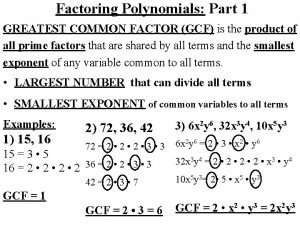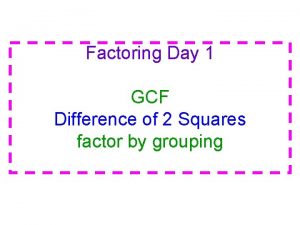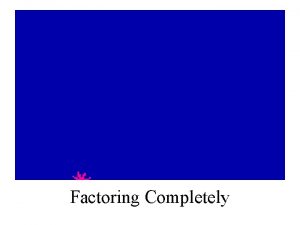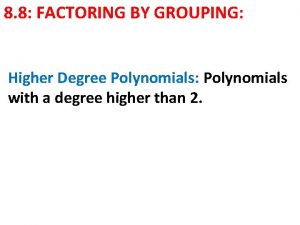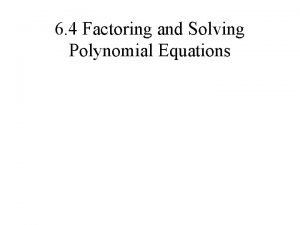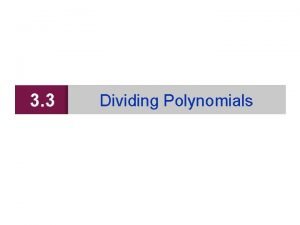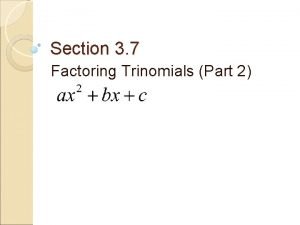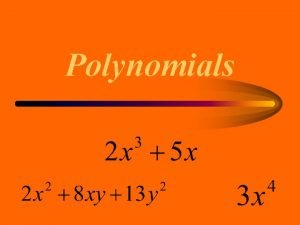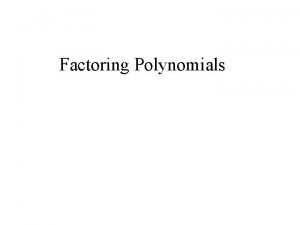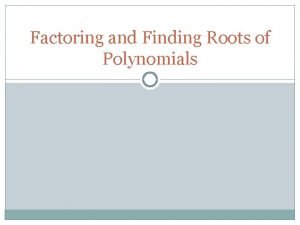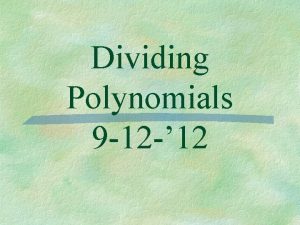Factoring Polynomials Factoring is the process of writing















- Slides: 15

Factoring Polynomials

Factoring is the process of writing a polynomial as the product of two or more polynomials. The factors of 6 x 2 – x – 2 are 2 x + 1 and 3 x – 2. In this section, we will be factoring over the integers. Polynomials that cannot be factored using integer coefficients are called irreducible over the integers or prime. The goal in factoring a polynomial is to use one or more factoring techniques until each of the polynomial’s factors is prime or irreducible. In this situation, the polynomial is said to be factored completely.

Common Factors In any factoring problem, the first step is to look for the greatest common factor. The greatest common factor is a n expression of the highest degree that divides each term of the polynomial. The distributive property in the reverse direction ab + ac = a(b + c) can be used to factor out the greatest common factor.

Text Example Factor: a. 18 x 3 + 27 x 2 b. x 2(x + 3) + 5(x + 3) Solution a. We begin by determining the greatest common factor. 9 is the greatest integer that divides 18 and 27. Furthermore, x 2 is the greatest expression that divides x 3 and x 2. Thus, the greatest common factor of the two terms in the polynomial is 9 x 2. 18 x 3 + 27 x 2 = 9 x 2(2 x) + 9 x 2(3) Express each term with the greatest common factor as a factor. = 9 x 2(2 x + 3) Factor out the greatest common factor. b. In this situation, the greatest common factor is the common binomial factor (x + 3). We factor out this common factor as follows. x 2(x + 3) + 5(x + 3) = (x + 3)(x 2 + 5) Factor out the common binomial factor.

A Strategy for Factoring ax 2 + bx + c (Assume, for the moment, that there is no greatest common factor. ) 1. Find two First terms whose product is ax 2: ( x + ) = ax 2 + bx + c 2. Find two Last terms whose product is c: (x + ) = ax 2 + bx + c 3. By trial and error, perform steps 1 and 2 until the sum of the Outside product and Inside product is bx: ( x + ) = ax 2 + bx + c I O (sum of O + I) If no such combinations exist, the polynomial is prime.

Text Example + + Factor: a. x 2 + 6 x + 8 b. x 2 + 3 x – 18 - + - - - + + -

Text Example Multiply to -24 and add to -10 Factor: 8 x 2 – 10 x – 3. 4 x 1 2 x 8 x 2 2 x -3 -12 x -3

The Difference of Two Squares • If A and B are real numbers, variables, or algebraic expressions, then • A 2 – B 2 = (A + B)(A – B). • In words: The difference of the squares of two terms factors as the product of a sum and the difference of those terms.

Text Example • Factor: 81 x 2 - 49 Solution: 81 x 2 – 49 = (9 x)2 – 72 = (9 x + 7)(9 x – 7).

Factoring Perfect Square Trinomials Let A and B be real numbers, variables, or algebraic expressions, 1. A 2 + 2 AB + B 2 = (A + B)2 2. A 2 – 2 AB + B 2 = (A – B)2

Text Example • Factor: x 2 + 6 x + 9. Solution: x 2 + 6 x + 9 = x 2 + 2 · x · 3 + 32 = (x + 3)2

Text Example • Factor: 25 x 2 – 60 x + 36. Solution: 25 x 2 – 60 x + 36 = (5 x)2 – 2 · 5 x · 6 + 62 = (5 x - 6)2.

Factoring the Sum and Difference of 2 Cubes Type Example A 3 + B 3 = (A + B)(A 2 – AB + B 2) x 3 + 8 = x 3 + 23 = (x + 2)( x 2 – x· 2 + 22) = (x + 2)( x 2 – 2 x + 4) A 3 – B 3 = (A – B)(A 2 + AB + B 2) 64 x 3 – 125 = (4 x)3 – 53 = (4 x – 5)(4 x)2 + (4 x)(5) + 52) = (4 x – 5)(16 x 2 + 20 x + 25)

Grouping Factor: x 3 – 5 x 2 – 4 x + 20 Solution x 3 – 5 x 2 – 4 x + 20 = (x 3 – 5 x 2) + (-4 x + 20) = x 2(x – 5) – 4(x – 5) = (x – 5)(x 2 – 4) = (x – 5)(x + 2)(x – 2) Group the terms with common factors. Factor from each group. Factor out the common binomial factor, (x – 5). Factor completely by factoring x 2 – 4 as the difference of two squares.

Grouping Factor: x 4 – 5 x 3 – 8 x + 40 Solution x 4 – 5 x 3 – 8 x + 40 = (x 4 – 5 x 3) + (-8 x + 40) = x 3(x – 5) – 8(x – 5) = (x – 5)(x 3 – 8) = (x – 5)(x – 2)(x 2 + 2 x + 4)
 Tic tac toe quadratic formula
Tic tac toe quadratic formula Factoring real life examples
Factoring real life examples Synthetic division method
Synthetic division method Foil factoring
Foil factoring Kyle muldrow
Kyle muldrow Factoring by gcf
Factoring by gcf Differnce of 2 squares
Differnce of 2 squares Factor gcf
Factor gcf Factoring higher degree polynomials
Factoring higher degree polynomials Factoring cases
Factoring cases Factoring polynomials with gcf
Factoring polynomials with gcf Solve for y
Solve for y Synthetic division of polynomials
Synthetic division of polynomials Essential questions for factoring polynomials
Essential questions for factoring polynomials Grouping method
Grouping method Factoring polynomials techniques
Factoring polynomials techniques





